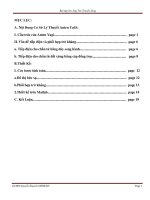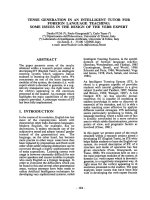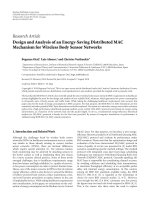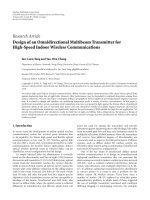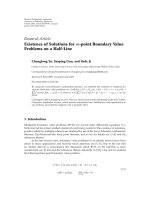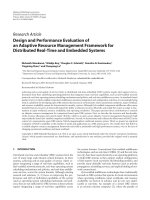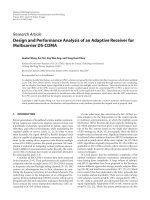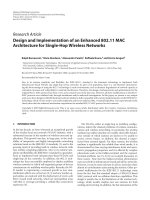báo cáo ăng ten và truyền sóng design an end fire right hand circularly polarized helix having a half
Bạn đang xem bản rút gọn của tài liệu. Xem và tải ngay bản đầy đủ của tài liệu tại đây (1.74 MB, 23 trang )
<span class="text_page_counter">Trang 1</span><div class="page_container" data-page="1">
<b>SINH VIÊN THỰC HIỆN: Đào Thị Kim Trang MSSV:20210854Đỗ Thùy Linh MSSV :20213982Chu Duy Hưng MSSV :20213956MÃ LỚP: 145521</b>
<b>GV HƯỚNG DẪN: Cô Nguyễn Hồng Anh</b>
<b>BÁO CÁO ĂNG TEN VÀ TRUYỀN SÓNG NHÓM 1</b>
<b>TRƯỜNG ĐẠI HỌC BÁCH KHOA HÀ NỘITRƯỜNG ĐIỆN- ĐIỆN TỬ</b>
</div><span class="text_page_counter">Trang 2</span><div class="page_container" data-page="2"><b>HÀ NỘI 2023</b>
<b> TÊN ĐỀ TÀI THỰC HIỆN – ĐỀ TÀI SỐ 21 </b>
Design an end-fire right-hand circularly polarized helix having a power beam- width of 45°, pitch angle of 13°, and a circumference of 60cm at a frequency of 500 MHz. Determine the
half-(a) turns needed (b) directivity (in dB) (c) axial ratio
(d) lower and upper frequencies of the bandwidth over which the required parameters remain relatively constant
(e) input impedance at the center frequency and the edges of the band from part (d).
Simulate your design (using Matlab) to validate.
f = 500Mhz
a)
</div><span class="text_page_counter">Trang 3</span><div class="page_container" data-page="3">∝=arctan ( <i>SC</i> ) S = <i>C ×</i>tan ∝ ¿<i>60. tan </i>(13) ¿<i>13.852(cm)</i>
<i><sub>HPBW =</sub>52. λ</i>
<i>c</i>√<i>N . S</i>=(52 60<i>×</i>
<i>π</i>
<small>2</small><i>× D</i>
<small>2</small>=<i><sup>( 2 N +1)</sup></i>
<i>2 N</i><sup>=</sup>
<i>(2× 5.7839 1</i>)+
<i>2 ×5.7839</i><sup>=1.083</sup> (3)d) <i>Frequency range</i>
<i>Lower frequency</i>
1. <i>Formals of lower frequency</i>
<i>C=</i>34<i><sup>× λ</sup></i>
<i><small>L</small></i><i>C=</i>43<i><sup>× λ</sup></i>
<i><small>H</small></i><i>λ</i>
<i><small>H</small></i>=<sup>3</sup>4<i><sup>× C=</sup></i>
-<i>Case1 : f</i>
<i><small>L</small></i><i>=375 Mhz</i>
<i>R</i>
<small>¿</small><i>=140 ×<sup>C</sup>λ=140 ×</i><sup>3</sup>
4<i><sup>=105(Ω)</sup></i>
</div><span class="text_page_counter">Trang 4</span><div class="page_container" data-page="4">-<i>Case2 : f</i>
<i><small>L</small></i><i>=667 Mhz</i>
<i>R</i>
<small>¿</small><i>=140 ×<sup>C</sup>λ</i>
<i><small>H</small></i>3<i><sup>=187 (Ω)</sup></i>*Chú thích:
(1) trích cơng thức 10-31 trang 510 (2) trích cơng thức 10-33 trang 510(3) trích cơng thức 10-34 trang 510
<b>Antenna-Theory-Analysis-and-Design-2nd-Edition-Contantine-a-II. Nội dung đóng góp các thành viên</b>
Đào Thị Kim Trang – Nhóm Trưởng –Tính tốn + matlabChu Duy Hưng – matlab + tìm nội dung
Đỗ Thùy Linh – matlab + tìm nội dung
<b>III. Phụ lục (code matlab mô phỏng)</b>
% I. Normal Mode
% a. Pitch angle alpha (in degrees)% b. Axial ratio (AR)% c. HPBW (in degrees)
% c. Directivity (dimensionless and in dB)% *
% II. Axial (End-Fire) Mode% a. Pitch angle alpha (in degrees)% b. Input impedance (ohms)% c. Axial ratio (AR)% d. Relative phase velocity ratio p
% e. HPBW (in degrees) (both approximate and numerical)% f. FNNW (in degrees) (both approximate and numerical)
% g. Directivity (dimensionless and in dB) (both approximate and numerical)% 1.Choice of output
% % Input 1 for Screen output% Input 2 for File output%
---% 2.Choice of radiation mode% ---% Input 1 to select Normal mode% Input 2 to select Axial (End-Fire) mode
</div><span class="text_page_counter">Trang 5</span><div class="page_container" data-page="5">%
---% a. Number of turns N
% b. Circumference of loops C (in lambda)% c. Spacing between turns S (in lambda)% *
% For axial mode, also need to select end-fire mode:% Input 1 to select Ordinary End-Fire
% Input 2 to select Hansen-Woodyard End-Fire%
% 4.Output% ---% I. Normal Mode
% a. Pitch angle alpha (in degrees)% b. Axial ratio (AR)% c. HPBW (in degrees)
% c. Directivity (dimensionless and in dB)% d. Plot the normalized radiation pattern (0 to -60 dB)%
% II. Axial (End-Fire) Mode% b. Input impedance (ohms)% c. Axial ratio (AR)% d. Relative phase velocity ratio p% e. HPBW (in degrees)
% A. Approximate (use Equation 10-31)% B. Numerical (found from pattern)% f. FNNW (in degrees)
% A. Approximate (use Equation 10-32)
% B. Numerical (found from pattern, set "zero" point to be less% than 1e-6)
% g. Directivity (dimensionless and in dB)% A. Approximate (use Equation 10-33)
% B. Numerical (calculated from equation D0=4*pi*Umax/Prad)% h. Plot the normalized radiation pattern (in dB: 0 to -60 dB)% ---
FILNAM = input('Input the desired output filename: ', );'s'
ERR = 0; else
fprintf('\nOutputting device number should be either 1 or 2\n'); end
</div><span class="text_page_counter">Trang 6</span><div class="page_container" data-page="6">%---Start of main
program---switch SELECT_mode, case 1
%---Normal mode---
fprintf('\nInput:\n'); fprintf('---\n');
%---Input turn numbers---
ERR = 1; while(ERR ~= 0)
N = str2num(input('Number of turns N = ', ));'s'
N = round(N); if (isempty(N))
fprintf('\n * ERROR: Please enter an integer!\n\n'); elseif (N <= 0)
fprintf('\n * ERROR: The number has to be greater than 0!\n\n');
elseif (N > 10)
fprintf('\n * WARNING: Large turn number may cause multi-lobe!\n\n');
ERR = 0; else
ERR = 0; end
end
%---Input circumference of
ERR = 1; while(ERR ~= 0)
fprintf('\n * NOTICE: For Normal mode, C << lambda.'); fprintf('\n It is recommended that C/lambda <= 1/10.\n\n');
C = str2num(input('Circumference of loops C (in lambda) = ', ));'s'
</div><span class="text_page_counter">Trang 7</span><div class="page_container" data-page="7">end
%---Input spacing between
ERR = 1; while(ERR ~= 0)
fprintf('\n * NOTICE: For Normal mode, S << lambda.'); fprintf('\n It is recommended that S/lambda <= 1/20.\n\n');
S = str2num(input('Spacing between turns S (in lambda) = ','s')); if (isempty(S))
fprintf('\n * ERROR: Please enter a number!\n\n'); elseif (S <= 0)
fprintf('\n * ERROR: The number has to be greater than 0!\n\n');
else
ERR = 0; end
end
%---Normal mode main %---Setup---
step=0.1; % Step: accuracy control
delta=1e-2; % To avoid sigularity in calculation
angle=[0+delta:step:360+delta]; theta=angle*pi/180;
%---Pitch
alpha=atan(S/C)*180/pi;
%---Axial
AR=2*S/C;
L0=sqrt(C^2+S^2); E=sin(theta); % Element factor
M=2*N; % Image due to ground plane
kesi=2*pi*(S*cos(theta));
AF=sin(M*kesi/2)./sin(kesi/2)/N; % Array factor
U=(E.*AF).^2; % Pattern mutiplicatin
[Umax,Index]=max(U); U=U/Umax; Umax=1; U_dB=10*log10(U);
%---HPBW(From
for i=Index:length(U) if U(i)<HP_dB
HPBW=angle(i)+angle(i-1)-2*angle(Index); break;
endend
</div><span class="text_page_counter">Trang 8</span><div class="page_container" data-page="8">
Prad=2*pi*sum(integrand(1:round(length(integrand)/2))); D0=4*pi*Umax/Prad;
D_dB=10*log10(D0);
%---Create
output---if(DEVICE == 2) fid = fopen(FILNAM,'w');
fid = DEVICE;
%---Echo input parameters and output computed
parameters---fprintf(fid,'\nHELIX: NORMAL MODE:\n');fprintf(fid,'\nInput parameters:\n---');fprintf(fid,'\nNumber of turns N = %3.0f',N);
fprintf(fid,'\nCircumference of loops C (in lambda) = %6.4f',C);fprintf(fid,'\nSpacing between turns S (in lambda) = %6.4f',S);fprintf(fid,'\nLength (one-turn) L0 (in lambda) = %6.4f',sqrt(C^2+S^2));fprintf(fid,['\nLength (',num2str(N),'-turn) LN (in lambda) = %6.4f'],N*sqrt(C^2+S^2));
fprintf(fid,'\n\nOutput parameters:\n---');fprintf(fid,'\nAxial Ratio AR (dimensionless) = %6.4f',AR);fprintf(fid,'\nHPBW (in degrees) = %6.4f',HPBW);fprintf(fid,'\nDirectivity(approximate) (dimensionless) = 1.5');fprintf(fid,'\nDirectivity(approximate) (in dB) = 1.7609');fprintf(fid,'\nDirectivity(numerical from pattern) (dimensionless) = %6.4f',D0);
fprintf(fid,'\nDirectivity(numerical from pattern) (in dB) \t= %6.4f',D_dB);fprintf(fid,'\n\n');
if(DEVICE == 2) fclose(fid);
%---Input turn numbers---
ERR = 1; while(ERR ~= 0)
N = str2num(input('Number of turns N = ', ));'s'
N = round(N); if (isempty(N))
fprintf('\n * ERROR: Please enter an integer!\n\n'); elseif (N <= 0)
fprintf('\n * ERROR: The number has to be greater than 0!\n\
</div><span class="text_page_counter">Trang 9</span><div class="page_container" data-page="9">ERR = 0; end
end
%---Input circumference of
ERR = 1; while(ERR ~= 0)
fprintf('\n * NOTICE: To achieve nearly circular polarizaion, it is');
fprintf('\n recommended that 3/4 <= (C/lambda) <= 4/3.\n\n');
C = str2num(input('Circumference of loops C (in lambda) = ', ));'s'
end
%---Input spacing between
ERR = 1; while(ERR ~= 0)
fprintf('\n * NOTICE: To achieve nearly circular polarizaion, it is');
fprintf('\n recommended that S/lambda is approximately 1/4.\n\n');
S = str2num(input('Spacing between turns S (in lambda) = ','s')); if (isempty(S))
fprintf('\n * ERROR: Please enter an number!\n\n'); elseif (S <= 0)
fprintf('\n * ERROR: The number has to be greater than 0!\n\n');
else
ERR = 0; end
end
%---Axial(End-fire) mode main %---Setup---
step=0.1; % Step: accuracy control
delta=1e-2; % To avoid sigularity in calculation
angle=[0+delta:step:360+delta]; theta=13*pi/180;
%---Choice of End-Fire
mode---ERR = 1;
while(ERR ~= 0)
fprintf('\nSELECT END-FIRE MODE:\n'); fprintf('---\n');
</div><span class="text_page_counter">Trang 10</span><div class="page_container" data-page="10">fprintf('(3) END-FIRE (p=1)\n\n');
SELECT_end = str2num(input('SELECT = ', ));'s'
(SELECT_end== 1)|(SELECT_end == 2)|(SELECT_end == 3)if
ERR = 0; endend
%---Numerical results from
pattern---if (SELECT_end ~= 3)
%---HPBW(From
for i=1:length(U) if U(i)<HP_dB
HPBW=angle(i)+angle(i-1);
</div><span class="text_page_counter">Trang 11</span><div class="page_container" data-page="11">endendelse
%---HPBW(From
endfor i=imax:-1:2 if U(i)<HP_dB
HPBW=angle(imax-i)+angle(imax-i+1); break;
endend
%---FNBW(From
pattern)---for i=imax:-1:2
U(i)<1e-4 if % set "zero" point to be less than 1e-4
FNBW=angle(imax-i)+angle(imax-i+1); break;
endend
%---Directivity(From
%---Create
output---if(DEVICE == 2) fid = fopen(FILNAM,'wt');
</div><span class="text_page_counter">Trang 12</span><div class="page_container" data-page="12">if (SELECT_end == 1)|(SELECT_end == 2)|(imax == 1)fprintf(fid,'\n\nOutput parameters:\n---');fprintf(fid,'\nInput impedance R (ohms)) = %6.4f',R);fprintf(fid,'\nAxial Ratio AR (dimesionless) = %6.4f',AR);fprintf(fid,'\nRelative phase velocity ratio p = %6.4f',p);fprintf(fid,'\n\nDirectivity:');
fprintf(fid,'\n A1. Approximate(10-33) (dimensionless) = %6.4f',D_app);fprintf(fid,'\n A2. Approximate(10-33) (in dB) = %6.4f',D_app_dB);fprintf(fid,'\n\n');
fprintf(fid,'\n\
fprintf(fid,'BAD DESIGN! MAXIMUM IS NOT AT 0 DEGREES!\n');
fprintf(fid,'PLEASE SEE THE PLOTTED RADIATION PATTERN FOR DETAILS.\n');
endif(DEVICE == 2) fclose(fid);
r = 0.3e-3;width = cylinder2strip(r);feedheight = 3*r;D = 56e-3;radius = D/2;turns = 6;pitch = 13;
spacing = helixpitch2spacing(pitch,radius);side = 600e-3;
radiusGP = side/2;
hx = helix('Radius',radius,'Width',width,'Turns',turns,'Spacing',spacing);fc = 1.65e9;
relativeBW = 0.45; BW = relativeBW*fc;
hx = helix('Radius',radius,'Width',width,'Turns',turns);figure;
show(hx);
</div><span class="text_page_counter">Trang 13</span><div class="page_container" data-page="13">Nf1 = 15;Nf2 = 20;fmin = 0.3e9;fmax = 0.7e9; fstep = 0.1e9;
fband1 = linspace(fmin,1.3e9,Nf1);fband2 = linspace(fmin,fmax,Nf2);freq = unique([fband1,fband2]);Nf = length(freq);D = nan(1,Nf);f_eng = freq./1e9;f_str = ;'G'
fig1 = figure;
for i = 1:length(freq) D(i) = pattern(hx,freq(i),0,90); figure(fig1)
plot(f_eng,D,'x-') grid on
axis([f_eng(1) f_eng(end) 9 16 ]) xlabel(['Frequency (' f_str 'Hz)']) ylabel('Directivity (dBi)')
title('Peak Directivity Variation vs. Frequency') drawnow
f = 500e6;figure(1)show(hx)figure(2)pattern(hx, f)figure(3)patternElevation(hx,f);figure(4)patternAzimuth(hx,f)figure(5)charge(hx, 93.5e6)
%impedance of the antenna
figure('name' 'Impedance', )impedance(hx, 1.5e8:10e6:f)
%Reflection Coeffcient of the antenna
figure('name', 'Reflection coefficient')S = sparameters(hx, 1.5e8:10e6:f,70);rfplot(S)
%Return Loss of the antenna
figure('name', 'Return Loss')returnLoss(hx, 1.5e8:10e6:f,70)
%VSWR of the antenna
figure('name', 'VSWR')vswr(hx, 1.5e8:10e6:f,70)directivity = pattern(hx, f, 0, 90);
disp('The directivity of the antenna in the direction from 0 degree');
</div><span class="text_page_counter">Trang 14</span><div class="page_container" data-page="14">File chạy kèm polar_dB.m
Input Parameters Description% ---
% - theta (in degrees) must be a row vector from 0 to 360 degrees% - rho (in dB) must be a row vector
% - rmin (in dB) sets the minimum limit of the plot (e.g., -60 dB)% - rmax (in dB) sets the maximum limit of the plot (e.g., 0 dB)% - rticks is the # of radial ticks (or circles) desired. (e.g., 4)% - linestyle is solid (e.g., '-') or dashed (e.g., '--')%
function hpol = polar_dB(theta,rho,rmin,rmax,rticks,line_style)
% Convert degrees into radians
theta = theta * pi/180;
% Font size, font style and line width parameters
font_size = 16;font_name = 'Times';line_width = 1.5;
</div><span class="text_page_counter">Trang 15</span><div class="page_container" data-page="15">error('Requires 5 or 6 input arguments.')
elseif nargin == 5
if isstr(rho)line_style = rho;rho = theta;[mr,nr] = size(rho);
if mr == 1theta = 1:nr;
th = (1:mr)';theta = th(:,ones(1,nr));
line_style = 'auto';
endelseif nargin == 1
line_style = 'auto';rho = theta;[mr,nr] = size(rho);
if mr == 1theta = 1:nr;
th = (1:mr)';theta = th(:,ones(1,nr));
'DefaultTextFontName', font_name, ...
'DefaultTextFontSize', font_size, ...
'DefaultTextFontWeight', get(cax, 'FontWeight') )
% only do grids if hold is off
</div><span class="text_page_counter">Trang 16</span><div class="page_container" data-page="16">hold ;on
% v returns the axis limits
% changed the following line to let the y limits become negative
hhh=plot([0 max(theta(:))],[min(rho(:)) max(rho(:))]);v = [get(cax,'xlim') get(cax,'ylim')];
ticks = length(get(cax,'ytick'));delete(hhh);
% check radial limits (rticks)
if rticks > 5 % see if we can reduce the number
if rem(rticks,2) == 0rticks = rticks/2;
elseif rem(rticks,3) == 0rticks = rticks/3;
% define a circle
th = 0:pi/50:2*pi;xunit = cos(th);yunit = sin(th);
% now really force points on x/y axes to lie on them exactly
inds = [1:(length(th)-1)/4:length(th)]; xunits(inds(2:2:4)) = zeros(2,1); yunits(inds(1:2:5)) = zeros(3,1);rinc = (rmax-rmin)/rticks;
% label r
% change the following line so that the unit circle is not multiplied
% by a negative number. Ditto for the text locations.
for i=(rmin+rinc):rinc:rmax is = i - rmin;
plot(xunit*is,yunit*is, ,'-' 'color',tc,'linewidth',0.5);text(0,is+rinc/20,[' ' num2str(i)],'verticalalignment' 'bottom',);
% plot spokes
th = (1:6)*2*pi/12;cst = cos(th); snt = sin(th);cs = [-cst; cst];sn = [-snt; snt];
plot((rmax-rmin)*cs,(rmax-rmin)*sn, ,'-' 'color',tc,'linewidth',0.5);
% plot the ticks
george=(rmax-rmin)/30; % Length of the ticks
th2 = (0:36)*2*pi/72; cst2 = cos(th2); snt2 = sin(th2);
cs2 = [(rmax-rmin-george)*cst2; (rmax-rmin)*cst2];sn2 = [(rmax-rmin-george)*snt2; (rmax-rmin)*snt2];plot(cs2,sn2, ,'-' 'color',tc,'linewidth',0.15); % 0.5
</div><span class="text_page_counter">Trang 17</span><div class="page_container" data-page="17">% Changed the next line to make the spokes long enough
rt = 1.1*(rmax-rmin);
for i = 1:max(size(th))
90)),'horizontalalignment','center' );
text(rt*cst(i),rt*snt(i),int2str(abs(i*30-if i == max(size(th))loc = int2str(90);
elseif i*30+90<=180loc = int2str(i*30+90); else
% set axis limits
% Changed the next line to scale things properly
% transform data to Cartesian coordinates.
% changed the next line so negative rho are not plotted on the other side
for i = 1:length(rho) (rho(i) > rmin)if
theta(i)*180/pi >=0 & theta(i)*180/pi <=90if
xx(i) = (rho(i)-rmin)*cos(pi/2-theta(i)); yy(i) = (rho(i)-rmin)*sin(pi/2-theta(i)); elseif theta(i)*180/pi >=90
xx(i) = (rho(i)-rmin)*cos(-theta(i)+pi/2); yy(i) = (rho(i)-rmin)*sin(-theta(i)+pi/2); elseif theta(i)*180/pi < 0
xx(i) = (rho(i)-rmin)*cos(abs(theta(i))+pi/2); yy(i) = (rho(i)-rmin)*sin(abs(theta(i))+pi/2); end
else
xx(i) = 0; yy(i) = 0; end
end
% plot data on top of grid
if strcmp(line_style,'auto')
</div><span class="text_page_counter">Trang 18</span><div class="page_container" data-page="18">q = plot(xx,yy,line_style);
endif nargout > 0
hpol = q;
endif ~hold_state
% reset hold state
if ~hold_state, set(cax,'NextPlot',next); end
